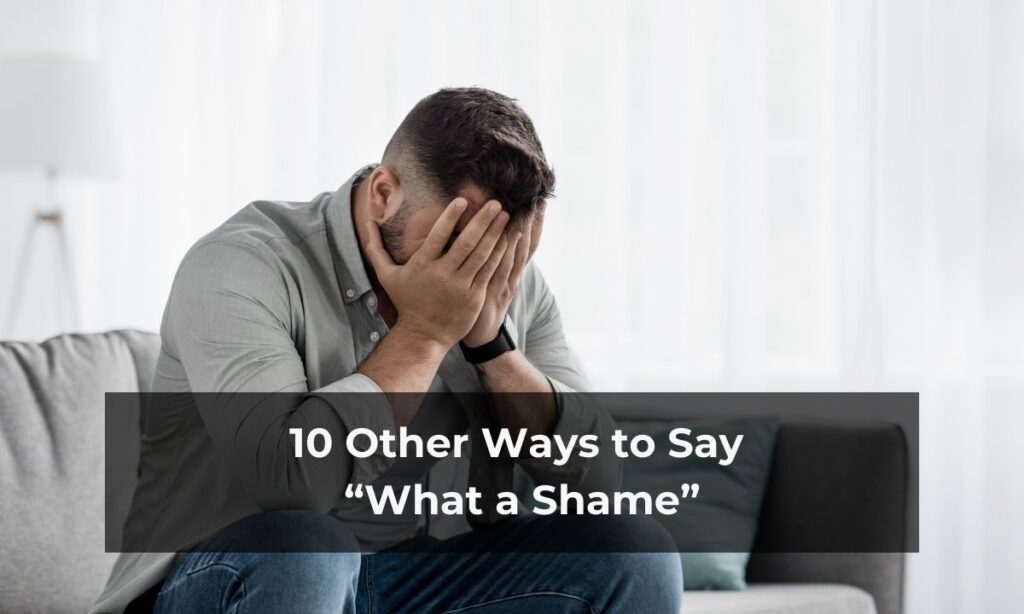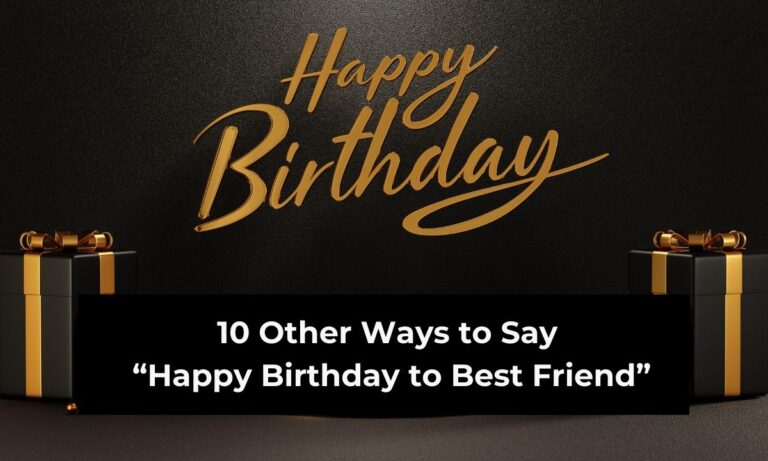Have you ever been in a situation where you wanted to express disappointment or sympathy, but the phrase “What a shame” felt too repetitive or flat? We’ve all been there. Language is powerful, and the words you choose shape how your message is received. Sometimes “What a shame” works just fine, but in other situations, it might sound a bit dismissive or lacking in emotion. That’s when having alternative phrases in your back pocket becomes so useful.
When you’re talking to a friend, colleague, or even a stranger, finding the right words can help you connect more deeply. For instance, if a friend shares some sad news, you might not want to rely on the same phrase every time. Using different expressions can help you sound more genuine, empathetic, and thoughtful. It shows you’re not just responding out of habit, but that you truly care about what the other person is experiencing.

In this article, you’ll discover 12 other ways to say “What a shame” that can make your conversations richer and more personal. Each alternative is explained with context so you’ll know when and how to use it. The goal is to give you a wide range of phrases you can draw from, whether you’re expressing sympathy, showing disappointment, or simply reacting to a situation that didn’t go as planned.
By the end, you’ll have a complete toolkit of words and phrases that let you move beyond the basic and connect on a more meaningful level. Let’s explore them together.
1. “That’s Too Bad”
This phrase is one of the most straightforward alternatives to “What a shame.” You can use it in casual conversations when something unfortunate has happened, but you don’t want to sound overly formal or dramatic.
For example, if a colleague mentions their weekend plans were ruined by heavy rain, responding with “That’s too bad” shows you care while keeping things light. It’s a flexible phrase you can use in both personal and professional situations without sounding insincere.
What makes “That’s too bad” effective is its balance—it expresses disappointment without adding unnecessary heaviness. It acknowledges the problem but doesn’t linger too much on the negative. That makes it a great choice for conversations where you want to show empathy but also keep the mood from becoming too somber.
If you’re aiming for a polite, conversational tone, this phrase is a safe and reliable option.
2. “How Unfortunate”
“How unfortunate” leans slightly more formal and is often used when you want to sound thoughtful and considerate. It carries a tone of genuine sympathy without being overly emotional.
Imagine a scenario where someone shares news about missing out on an opportunity they were excited about. Saying “How unfortunate” communicates that you recognize their disappointment and empathize with the situation.
This phrase works particularly well in professional settings or when speaking with someone you don’t know very well. It helps maintain respect while still acknowledging the difficulty of what the other person is going through.
Compared to “That’s too bad,” this option feels a bit more refined. It’s the kind of phrase you might use in emails, polite conversations, or even formal discussions where empathy is expected but casual expressions might feel out of place.
3. “That’s Disappointing”
Sometimes, the best response is the most direct one. “That’s disappointing” is clear, honest, and lets the other person know you truly understand their feelings. It avoids sounding cliché and instead mirrors the emotion of the situation.
For instance, if a friend tells you their favorite restaurant is closing down, you might naturally say, “That’s disappointing.” It shows that you’re not just brushing off their comment—you actually share in their sense of loss.
This phrase works especially well when you want to validate someone’s emotions. Instead of sounding detached, it communicates that you recognize the frustration or sadness behind their words. It can even strengthen trust because you’re affirming how they feel rather than just acknowledging the facts.
In everyday conversations, “That’s disappointing” is both practical and meaningful, making it an excellent alternative.
4. “I’m Sorry to Hear That”
This phrase adds a personal touch of empathy and compassion. When you say “I’m sorry to hear that,” you’re not just commenting on the situation—you’re expressing that you feel for the other person.
For example, if someone shares that they didn’t get a promotion they were hoping for, saying “I’m sorry to hear that” shows more warmth than simply saying “What a shame.” It lets them know you’re acknowledging not only the situation but also their emotions.
This expression is especially powerful in close relationships. It creates a sense of connection, making the other person feel supported. It’s also an excellent option for professional conversations, where offering genuine empathy can make you seem approachable and understanding.
5. “What a Pity”
“What a pity” is a classic alternative that carries a touch of formality. It’s commonly used in British English but is also understood worldwide. The phrase conveys sympathy in a way that feels polite and slightly refined.
For instance, if someone mentions they couldn’t attend an event they were looking forward to, “What a pity” acknowledges the situation while keeping the tone respectful.
Compared to “That’s too bad,” this option feels a little more elegant. It’s useful when you want to sound caring without being overly casual. Because of its traditional feel, you might hear it more in written communication, books, or formal conversations.
6. “That’s Regrettable”
“That’s regrettable” works well in situations where something disappointing has happened that could have been avoided or that carries weight. It communicates seriousness while still being polite.
You might use this phrase when responding to news about a canceled project at work or a missed opportunity that had important consequences. For example, if a business partner mentions a deal falling through, saying “That’s regrettable” shows understanding and professionalism.
This phrase is not usually used in casual conversations. Instead, it’s better suited for formal contexts where showing empathy while maintaining professionalism is key. It tells the other person you’re acknowledging the setback without being overly personal.
7. “That’s Heartbreaking”
When the situation is more emotional and serious, “That’s heartbreaking” can express deeper empathy than “What a shame.” It shows that you’re truly moved by the news and that you understand the weight of the other person’s feelings.
For example, if someone tells you about a personal loss, a breakup, or a deeply disappointing event, saying “That’s heartbreaking” lets them know you’re sharing in their sadness.
Unlike lighter phrases like “That’s too bad,” this expression carries a stronger emotional impact. It should be reserved for situations that genuinely call for compassion. Using it in trivial circumstances could feel insincere, so it’s best to match the tone carefully.
8. “That’s Discouraging”
Sometimes, the disappointment isn’t devastating but still feels like a setback. In these cases, “That’s discouraging” can be a perfect fit. It communicates empathy while recognizing that the situation has taken away some motivation or energy.
For instance, if someone has been working hard toward a goal but faces a temporary roadblock, you might say, “That’s discouraging.” This helps them feel validated and understood, rather than brushed aside.
It’s especially useful in professional or motivational contexts, where acknowledging discouragement can lead into offering encouragement or support. By recognizing their struggle, you create space for positivity and resilience.
9. “That’s Unfortunate”
“That’s unfortunate” is simple, neutral, and professional. It’s similar to “How unfortunate,” but with a slightly softer tone. You can use it in almost any context without worrying about sounding too casual or too formal.
For example, if a coworker explains that a shipment was delayed, saying “That’s unfortunate” keeps the conversation polite and respectful.
This phrase works well in professional communication, including emails and meetings. It’s straightforward and doesn’t carry unnecessary emotional weight, making it a versatile choice in your vocabulary.
10. “That’s Sad to Hear”
When you want to add more personal warmth, “That’s sad to hear” is a gentle and compassionate alternative. It acknowledges the emotional side of the situation and helps the other person feel understood.
For example, if a friend tells you they’re moving away, you might respond with “That’s sad to hear.” It not only validates the situation but also subtly expresses your own feelings of loss.
This phrase is best used in personal conversations where emotions are involved. It creates a human connection and shows that you genuinely care about what the other person is experiencing.
11. “That’s Miserable”
When you want to express a stronger sense of sympathy, “That’s miserable” can work well. It emphasizes the unpleasantness of the situation while showing genuine concern.
For instance, if someone tells you they’ve been sick all week and missed out on something important, you might say, “That’s miserable.” This reflects that you understand how difficult the situation must have been for them.
This phrase works better in casual or semi-casual settings. It’s less formal, but it adds a strong layer of empathy and acknowledgment.
12. “That’s Rough”
“That’s rough” is an informal and modern way to show sympathy or understanding. It works particularly well in casual conversations with friends or peers.
For example, if someone shares that they had a stressful day full of unexpected problems, responding with “That’s rough” shows quick empathy in a relaxed way.
It’s a phrase that communicates understanding without being overly heavy. Because of its casual tone, it’s perfect for everyday situations where you want to show you care but keep things conversational.
Conclusion
Finding the right words to express sympathy or disappointment matters more than you might think. While “What a shame” is a common and acceptable phrase, using alternatives can make your communication more heartfelt, personal, and versatile. Each of the 12 options we’ve explored has its own unique tone, ranging from casual and friendly to formal and compassionate.
By choosing the right expression, you can connect with people more meaningfully and show that you’re truly paying attention to their feelings. Whether you’re talking to a close friend, a coworker, or someone you don’t know well, these alternatives give you the flexibility to respond in a way that feels authentic and supportive.
So the next time you’re tempted to say “What a shame,” pause for a moment. Consider the situation, the emotions involved, and the relationship you have with the person. Then, choose a phrase that communicates not just words, but empathy, care, and understanding. With these alternatives, your conversations will feel more genuine and thoughtful.
FAQs
1. Is “What a shame” rude?
Not usually. It’s a polite way to express disappointment, but it can sometimes sound insincere if overused.
2. Which alternative is best for professional settings?
Phrases like “That’s unfortunate,” “How unfortunate,” or “That’s regrettable” work best in professional contexts.
3. What can I use instead of “What a shame” in casual conversations?
Options like “That’s rough,” “That’s too bad,” or “That’s miserable” are better suited for casual settings.
4. Is “What a pity” the same as “What a shame”?
Yes, they’re very similar. “What a pity” is slightly more formal and traditional, often used in British English.
5. How do I make my responses sound more genuine?
Match your words to the tone of the situation and the person you’re speaking to. Showing empathy and sincerity matters more than the phrase itself.





